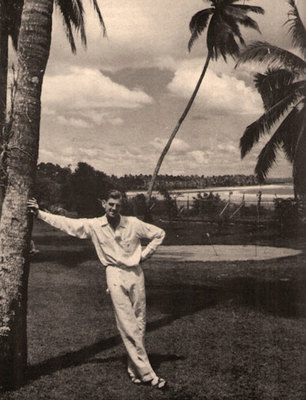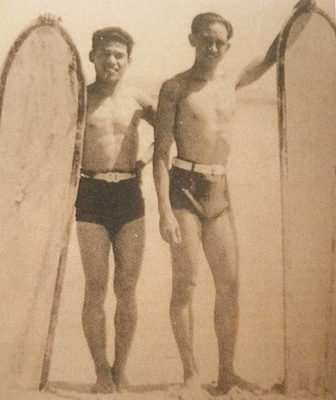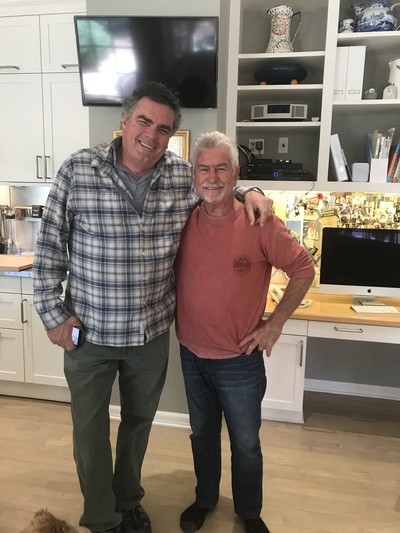By Phil Jarratt
A couple of hours after touching down in LAX in the wee hours we’d checked into the “Jarratt Wing” of our friends’ rambling Pacific Palisades spread and climbed into bed for a nanna nap that took care of most of the day.
When I finally opened my eyes it was beer o’clock and Oliver Garrett had come around to share a few Modelos. Although I’d written extensively about his family history and exchanged emails with him, I’d never actually met Oliver, who is a friend and neighbor to our LA mates, the Hills. So it was quite a shock to open the door to the kitchen and be confronted by a giant of a man with a friendly smile and a beer in one hand and the other extended to me.
We got along like wildfire and sat down to talk story, and what a story Oliver has.
In the late 1920s his grandmother Louise, a talented painter, married the Hollywood writer and director Oliver H.P. Garrett, a former New York City newspaper reporter who heard the clarion call for more and more scripts at the dawn of the talkies, caught the train to Los Angeles and made his fortune with a string of hits, including A Farewell To Arms. The couple moved into a dream home just around the corner from where we’re sitting this spring afternoon, on the Palisades above Santa Monica Bay, and had a perfect life, for a while.
But old Ollie had a roving eye, and while he was off shooting a movie in Hungary and romancing the female lead, a beautiful Hungarian model, she took comfort in the arms of her tennis coach, Bob Koke. Born in Los Angeles in 1910, the tall, fit Koke studied at the University of California before getting a job in the production department at MGM, where one of his first assignments was to travel to Hawaii as assistant to director King Vidor on the 1932 film Bird of Paradise, starring Dolores Del Rio. Although he had grown up not far from the beach, this was Koke’s first real experience of surf culture, and he loved it. Soon he was riding big redwood surfboards alongside the beach boys at Waikiki. But his career in the film industry didn’t go much further, and he was soon back in LA teaching tennis.
When Oliver Garrett returned to LA with his Hungarian model in tow, Louise spat the dummy and filed for divorce. Then she ran away to the Far East with her tennis coach. The couple left Los Angeles in October 1934, bound for Yokohama, then travelled through Japan, Shanghai and Hong Kong before arriving in Bali in August 1936. This is the point where I picked up the story while researching the social history of Bali some years ago.
The Kokes (which was how they presented themselves, to avoid scandal) checked into the Bali Hotel in Denpasar, where they met the woman who was to turn their Far East dream into a nightmare. K’tut Tantri (real name Muriel Pearsen) was a short, frumpy Scots woman who was unhappily married and living in Los Angeles when she saw the film Goona-Goona at a Hollywood cinema and immediately booked a single passage to Bali. So it was Hollywood and a broken marriage that brought both Tantri and Louise to Bali, but that was all the women had in common.
Louise later wrote: “On the second or third day we were having drinks on the veranda and who should show up but a dumpy woman in a sarong, horn-rimmed glasses, black hair, and she spoke English. She rented us a car and … showed us Kuta Beach.”
The particular part of Kuta Beach she showed them was a couple of acres of beachfront where the Hard Rock Hotel now sits. Tantri had this mad dream of building Bali’s first beachfront hotel, and who should rock up but a couple of mad dreamers! Tantri and the Kokes became partners in a joint venture that started to fall apart almost before it began, with threats of violence and litigation, public spats in bars and restaurants, the full monty. But Bob Koke was a man who got things done, and despite dodgy builders and Tantri’s mad presence, he and Louise opened the doors of the Kuta Beach Hotel early in 1937.
Bob sent to Hawaii for a couple of his redwood surfboards to be shipped out, and when they arrived he taught his houseboys how to surf, then helped them build their own shorter, lighter boards. So Koke not only built the first beachfront hotel in Bali, he also introduced surfing there.
But then the Japanese invaded. Bob managed to get Louise on a cruise ship out of Surabaya, then later tried to hitch a ride home on US Air Force planes, where he was told it would be better if he enlisted. So began a distinguished career with the Office of Strategic Services (the forerunner of the CIA) in Batavia and Shanghai, and with the South East Asia Command.
In March 1946, just as the Dutch landings began on Bali, a tall, tanned American stood on the beach at Kuta, shaking his head at the panorama of rubble that extended from his feet to Jalan Pantai way to the south. Bob Koke took off his army cap, wiped his brow and kicked at the dirt, revealing the remains of the concrete wall of the laundry block that had once been part of the Kuta Beach Hotel.
Back in the States, he and Louise moved to rural Virginia, near CIA headquarters at Langley, where Oliver Garrett and his brother would visit their grandparents during semester breaks. Oliver chuckles at the memory. “We’d always try to get Bob a bit drunk, because although he’d signed the oath, the stories would tumble out.”
Yep, I said, should be a Hollywood movie.








